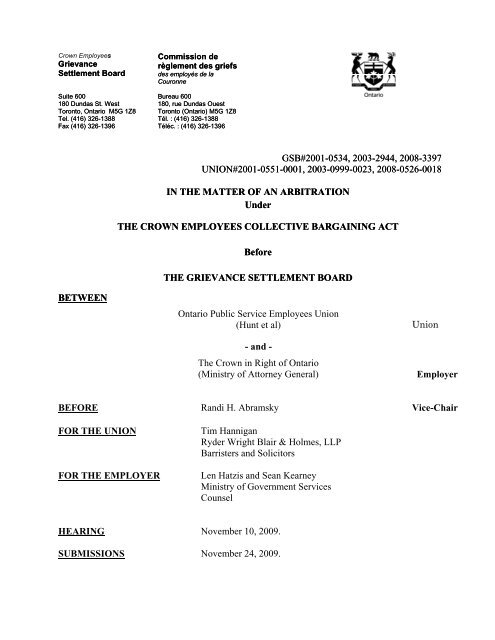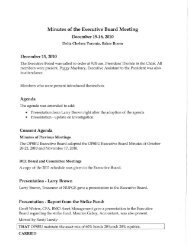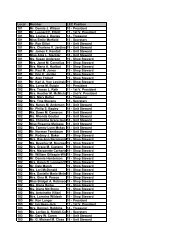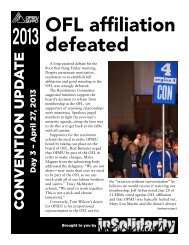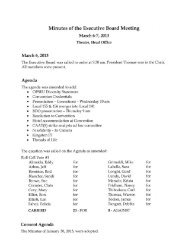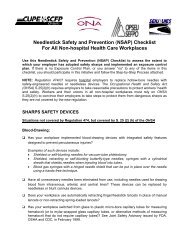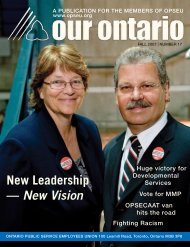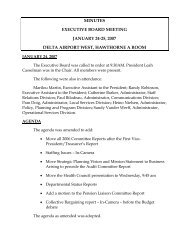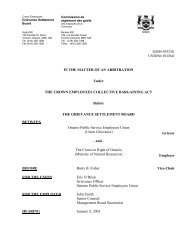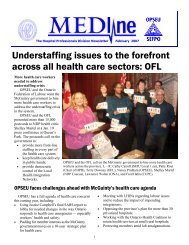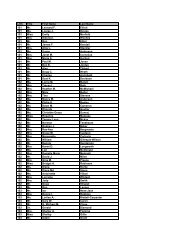2009 - OPSEU (Hunt et al) and Ministry of Attorney General, GSB ...
2009 - OPSEU (Hunt et al) and Ministry of Attorney General, GSB ...
2009 - OPSEU (Hunt et al) and Ministry of Attorney General, GSB ...
- No tags were found...
Create successful ePaper yourself
Turn your PDF publications into a flip-book with our unique Google optimized e-Paper software.
- 4 -prospective remedies. In particular, in light <strong>of</strong> the grievances <strong>and</strong> the nature <strong>of</strong> the dispute theEmployer sh<strong>al</strong>l seek an Order by way <strong>of</strong> a preliminary motion that the <strong>GSB</strong> does not have thejurisdiction to consider the issue <strong>of</strong> prospective remedies such as how the transcript function is tobe delivered in the province <strong>of</strong> Ontario.”[7] In the <strong>al</strong>ternative, in the event that the Board did not accept that position, the Employerindicated that it would argue that it should be permitted to begin the process <strong>of</strong> implementation<strong>of</strong> the changes it proposed.[8] In the Union’s response to the Employer’s particulars, the Union asserted in regard to thejurisdiction<strong>al</strong> issue that “it will vehemently oppose the Employer’s motion. The <strong>GSB</strong> hasd<strong>et</strong>ermined that there has been a breach <strong>of</strong> the Collective Agreement. The <strong>GSB</strong> has thejurisdiction to remedy the wrong committed by the Employer which, in the Union’s submission,includes the jurisdiction to order a prospective remedy in the context <strong>of</strong> this case.”[9] In terms <strong>of</strong> the Employer’s <strong>al</strong>ternative argument, it asserted that the <strong>GSB</strong> had “<strong>al</strong>readymade a d<strong>et</strong>ermination with respect to the Employer’s desire to unilater<strong>al</strong>ly impose a remedy withrespect to this matter in a decision dates July 17 th <strong>2009</strong>” <strong>and</strong> that the Employer “was, in essence,seeking reconsideration <strong>of</strong> the <strong>GSB</strong>’s decision, which is absolutely inappropriate.”[10] Full argument was heard on the Employer’s preliminary objection in regard tojurisdiction on November 10, <strong>2009</strong>.
- 5 -1. Did the July 17, <strong>2009</strong> Decision Already Decide this Issue?[11] The Union asserts that the Board, in the July 17, <strong>2009</strong> decision, made a d<strong>et</strong>erminationthat the Employer may not implement its plan <strong>and</strong> that the Employer should not be <strong>al</strong>lowed, atthis juncture, to reargue that issue. It contends that the <strong>GSB</strong> has no power to reconsider itsd<strong>et</strong>erminations, citing Re Canadian Broadcasting Corporation <strong>and</strong> Joyce <strong>et</strong> <strong>al</strong>. (1997) 34O.R.(3d) 493 (Ont. Div. Ct.); Re <strong>OPSEU</strong> (Ross Grievance) <strong>and</strong> Ontario (<strong>Ministry</strong> <strong>of</strong> Municip<strong>al</strong>Affairs <strong>and</strong> Housing) [<strong>2009</strong>] O.G.S.B.A. No. 54 (Gray); Re <strong>OPSEU</strong> (Transition Grievance) <strong>and</strong>Ontario (<strong>Ministry</strong> <strong>of</strong> Community Saf<strong>et</strong>y <strong>and</strong> Correction<strong>al</strong> Services)[2005] O.G.S.B.A. No. 56(Briggs). It contends that the principle <strong>of</strong> issue estoppel applies, <strong>and</strong> that the Board’s earlierdecision must be respected <strong>and</strong> adhered to. Re Ontario Liquor Board Employees’ Union <strong>and</strong>Ontario (Liquor Control Board <strong>of</strong> Ontario) [2002] O.G.S.B.A. No. 10 (Mikus); Re City <strong>of</strong>Toronto <strong>and</strong> CUPE, Loc<strong>al</strong> 79 [2003] S.C.J. No. 64 (S.C.C.). The Union submits that there isnothing different about the situation now than there was in July, <strong>and</strong> that the Employer is raisingthe same question – wh<strong>et</strong>her the Employer may implement its response to the <strong>Hunt</strong> decisionunilater<strong>al</strong>ly.[12] The Employer asserts that the issue is not the same. The Employer submits that the scope<strong>of</strong> the Board’s jurisdiction has never been d<strong>et</strong>ermined <strong>and</strong> that there is, therefore, no issueestoppel to apply. The Employer, it submits, has fully adhered to the Board’s d<strong>et</strong>ermination notto implement its plan until the matter could be addressed by the Board. It submits that thismotion is the first step in addressing the matter before the Board.
- 6 -[13] I conclude that the July 17, <strong>2009</strong> decision did not address the issue <strong>of</strong> the scope <strong>of</strong> theBoard’s jurisdiction in regard to prospective remedies in this case. Although the Employerargued that the <strong>Hunt</strong> decision did not impact its Article 2 management rights to manage thebusiness or constrain the Employer’s right to act unilater<strong>al</strong>ly, the issue was not framed as ajurisdiction<strong>al</strong> argument. The scope <strong>of</strong> the Board’s remedi<strong>al</strong> authority/jurisdiction in this matterhas not been raised before. As stated in paragraph 13 <strong>of</strong> the decision: “The question presentedtoday is wh<strong>et</strong>her [the Employer] can implement its plan to de<strong>al</strong> with the <strong>Hunt</strong> decisionunilater<strong>al</strong>ly at this time. In my view, the Employer’s implementation <strong>of</strong> its plan at this point intime circumvents the hearing process underway <strong>and</strong> undermines the integrity <strong>of</strong> the Board’sprocesses.”[14] The decision <strong>al</strong>so did state that “[t]o accept the Employer’s argument would <strong>al</strong>low theEmployer to d<strong>et</strong>ermine the appropriate remedy, <strong>and</strong> require the Union to ch<strong>al</strong>lenge thatdecision.” The Board d<strong>et</strong>ermined that “that would be inconsistent with the param<strong>et</strong>ers <strong>of</strong> thedispute resolution process that is in play in this instance. Once a decision has been made <strong>and</strong> thearbitrator is seized with implementation <strong>of</strong> a decision, as is the case here, the parties try to com<strong>et</strong>o an agreement with respect to the remedy. If they cannot do so, they r<strong>et</strong>urn to the Board, theypresent their respective positions, <strong>and</strong> the Board makes a d<strong>et</strong>ermination.” While this paragraph,especi<strong>al</strong>ly the first part <strong>of</strong> it, may appear to d<strong>et</strong>ermine that the Board’s remedi<strong>al</strong> powerencompasses how the Employer is to implement the <strong>Hunt</strong> decision, the remainder <strong>of</strong> theparagraph, as well as paragraph 13, makes it clear that it is the Employer’s unilater<strong>al</strong> action thatis in dispute in the July 17, <strong>2009</strong> decision. They must “r<strong>et</strong>urn to the Board… present theirrespective positions, <strong>and</strong> the Board makes a d<strong>et</strong>ermination.”
- 9 -[20] In making a d<strong>et</strong>ermination on this issue, it is important to review what was decided in<strong>Hunt</strong>. There were two grievances involved in this matter. The first, a group grievance filed bythree classified Court Reporters, <strong>al</strong>leged that they had “been forced to perform authorized dutieson overtime hours with no overtime pay, contrary to Article OAD 8.31 [<strong>and</strong> 8.4] <strong>of</strong> the collectiveagreement.” The s<strong>et</strong>tlement desired was “Full redress to include overtime pay owing for the lastten years c<strong>al</strong>culated on government T4’s for this period, based on the <strong>Ministry</strong>’s st<strong>and</strong>ard <strong>of</strong>seven pages per hour.”The second was a policy grievance, which states:The work associated with the preparation <strong>and</strong> production <strong>of</strong> typ<strong>et</strong>ranscripts <strong>and</strong> certifying them as accurate is bargaining unitwork to which the collective agreement applies.The s<strong>et</strong>tlement desired was:1. A declaration that the work associated with the preparation <strong>and</strong>production <strong>of</strong> typed transcripts <strong>and</strong> certifying them as accurateis bargaining unit work to which the collective agreement applies.2. That the Union <strong>and</strong> <strong>al</strong>l affected persons be made whole includinginterest.3. Any other remedy that the Board deems appropriate.[21] After many days <strong>of</strong> hearing regarding how transcription services were performed in theprovince <strong>of</strong> Ontario <strong>and</strong> the control (or lack <strong>of</strong> control) that the Employer exercised, the Boardaccepted the Union’s position that transcription work was the work <strong>of</strong> the Court Reporters asemployees, not as independent contractors, as the Employer had asserted.The d<strong>et</strong>ermination was as follows:I d<strong>et</strong>ermine that the preparation <strong>and</strong> certification <strong>of</strong> transcripts is bargaining unitwork <strong>of</strong> the Court Reporters, <strong>and</strong> so declare.
- 10 -[22] What this means – as requested in the policy grievance – is that the preparation <strong>and</strong>certification <strong>of</strong> transcripts is work <strong>of</strong> the bargaining unit, specific<strong>al</strong>ly the Court Reporters, towhich the collective agreement applies. It <strong>al</strong>so means that <strong>OPSEU</strong> is the exclusive representative<strong>of</strong> the Court Reporters for that work. The decision had implications r<strong>et</strong>rospectively – the CourtReporters <strong>and</strong> the Union were entitled to <strong>al</strong>l the benefits <strong>of</strong> the collective agreement. It <strong>al</strong>so hadprospective implications – the Employer could not refuse to recognize <strong>OPSEU</strong> as the exclusiverepresentative, nor could it treat the Court Reporters as f<strong>al</strong>ling outside <strong>of</strong> the collectiveagreement in regard to transcription work. The decision was based on the evidence <strong>and</strong> factsestablished at the hearing.[23] The decision, however, did not <strong>al</strong>ter the parties’ rights under the collective agreement,nor could it do so. Article 22.13.6 provides that “[t]he <strong>GSB</strong> sh<strong>al</strong>l have no jurisdiction to <strong>al</strong>ter,change, amend or enlarge any provision <strong>of</strong> the Collective Agreement.” The Employer r<strong>et</strong>ainedwhatever rights it has under the collective agreement, as did the Union.[24] That includes Article 2 <strong>of</strong> the collective agreement. Article 2 <strong>of</strong> the Collective Agreementstates:Management Rights2.1 For the purpose <strong>of</strong> this Centr<strong>al</strong> Collective Agreement <strong>and</strong> any other CollectiveAgreement to which the parties are subject, the right <strong>and</strong> authority to manage thebusiness <strong>and</strong> direct the workforce, including the right to hire <strong>and</strong> lay-<strong>of</strong>f, appoint,assign <strong>and</strong> direct employees; ev<strong>al</strong>uate <strong>and</strong> classify positions, discipline, dismiss orsuspend employees for just cause; d<strong>et</strong>ermine organization, staffing levels, workm<strong>et</strong>hods, the location <strong>of</strong> the workplace, the kinds <strong>and</strong> locations <strong>of</strong> equipment, themerit system, training <strong>and</strong> development <strong>and</strong> apprais<strong>al</strong>; <strong>and</strong> make reasonable rules<strong>and</strong> regulations; sh<strong>al</strong>l be vested exclusively in the Employer. It is agreed that
- 11 -these rights are subject only to the provisions <strong>of</strong> this Centr<strong>al</strong> CollectiveAgreement <strong>and</strong> any other Collective Agreement to which the parties are subject.[25] The <strong>Hunt</strong> decision did not declare that only part <strong>of</strong> the collective agreement applied totranscription services.[26] It is against this background that the case law must be considered. The case law suppliedby the parties, particularly by the Union, clearly establishes that the <strong>GSB</strong> has broad remedi<strong>al</strong>authority. This was established in <strong>OPSEU</strong> (Berry <strong>et</strong> <strong>al</strong>.) <strong>and</strong> Ontario (<strong>Ministry</strong> <strong>of</strong> Community<strong>and</strong> Soci<strong>al</strong> Services [1986] O.J. No. 152. In that case, the issue was “wh<strong>et</strong>her the Board hadpower to require the employer to find or create a classification for the grievors.” The majority <strong>of</strong>the Board had held that even though the grievors were not properly classified they did not fit theclassification they sought, <strong>and</strong> therefore the grievance had to be dismissed. A dissent byPr<strong>of</strong>essor Paul Craven d<strong>et</strong>ermined that the <strong>GSB</strong> should have ordered the Employer “to classifythe grievor properly.” The Court decided that the Board did have that power, stating at p. 6-7:Simply to dismiss the grievances when it acknowledges that the grievors arewrongly classified is to empty the grievance procedure <strong>of</strong> any meaning. It iscommonplace <strong>of</strong> the law that the existence <strong>of</strong> a right implies the existence <strong>of</strong> aremedy.…The board’s obligation under s. 19(1) [<strong>of</strong> the Crown Employees CollectiveBargaining Act] is to “decide the matter”. When looked at without theconfinement imposed by Article 5.1.2 “the matter” grieved was wrongclassification. If the board concluded that the classification was wrong, itsm<strong>and</strong>ate was to effect a proper classification. Its jurisdiction is unrestricted. Itsm<strong>and</strong>ate is remedi<strong>al</strong>. …[27] This broad remedi<strong>al</strong> power was further endorsed in <strong>OPSEU</strong> (Anderson <strong>et</strong> <strong>al</strong>.) <strong>and</strong>Ontario (<strong>Ministry</strong> <strong>of</strong> Natur<strong>al</strong> Resources)(1990), 75 O.R. (2d) 212 (Ont. Div. Ct.). In that case,
- 12 -the Division<strong>al</strong> Court <strong>of</strong> Ontario concluded that “[t]he power to implement a proper classificationmust necessarily include the power to review the contents <strong>of</strong> the classification for sufficiency <strong>and</strong>instruct management to <strong>al</strong>ter or amend the class st<strong>and</strong>ard to reflect properly the duties,responsibilities, <strong>et</strong>c., <strong>of</strong> the grievors.” The Court continued, at p. 8:The power to require management to create a proper classification necessarilyincludes the power to require management to g<strong>et</strong> it right. To hold otherwise wouldrestrict the unrestricted remedi<strong>al</strong> jurisdiction, referred to in Berry, to effect aproper classification. To hold otherwise would defeat the legislative object <strong>of</strong>efficient <strong>and</strong> fin<strong>al</strong> s<strong>et</strong>tlement <strong>of</strong> grievances. It would promote the very mischiefdescribed by the board: multiplicity <strong>of</strong> proceedings, exhausting <strong>and</strong> protracteddelay, frustration, needless inefficiency.[28] The extensive remedi<strong>al</strong> power <strong>of</strong> arbitrators has <strong>al</strong>so been recognized by the SupremeCourt <strong>of</strong> Canada in Alberta Union Of Provinci<strong>al</strong> Employees v. L<strong>et</strong>hbridge Community College[2004] S.C.J. No. 24 (S.C.C.), where the Court upheld the power <strong>of</strong> a board <strong>of</strong> arbitration toaward damages in lieu <strong>of</strong> reinstatement in an appropriate case. The Court stated at par. 54:For arbitration to be effective, efficient <strong>and</strong> binding it must provide lasting,practicable solutions to workplace problems. Commensurate with the notion <strong>of</strong>exception<strong>al</strong> circumstances as developed in arbitr<strong>al</strong> jurisprudence is the need forarbitrators to be liber<strong>al</strong>ly empowered to fashion appropriate remedies, taking intoconsideration the whole <strong>of</strong> the circumstances. To rob arbitrators <strong>of</strong> access to thefull breadth <strong>of</strong> the employment context risks impairing their role as fin<strong>al</strong> arbiters<strong>of</strong> workplace disputes. …[29] I <strong>al</strong>so find the <strong>GSB</strong>’s decision in <strong>OPSEU</strong> (Howe/D<strong>al</strong>ton/Loach) <strong>and</strong> Ontario (<strong>Ministry</strong> <strong>of</strong>Correction<strong>al</strong> Services (1994), 42 LA.C. (4 th ) 342 (Dissanayake) to be particularly instructive. Inthat case, a dispute arose as to the scope <strong>of</strong> the board’s remedi<strong>al</strong> jurisdiction in the event that thesexu<strong>al</strong> harassment grievances <strong>of</strong> the three grievors were upheld. Specific<strong>al</strong>ly, the issue waswh<strong>et</strong>her the board could order the employer to take specific action against the <strong>al</strong>leged harassers,namely, that they be transferred or discharged. The issue was framed as follows: “Does the
- 13 -Grievance S<strong>et</strong>tlement Board have jurisdiction to direct the employer to take any specificdisciplinary action against a member <strong>of</strong> management, as a remedy in a sexu<strong>al</strong>harassment/discrimination grievance?”[30] “The starting point for a review <strong>of</strong> this board’s remedi<strong>al</strong> jurisdiction”, the Board stated,“was Section 19(1) <strong>of</strong> the Crown Employees Collective Bargaining Act <strong>and</strong> its m<strong>and</strong>ate that theBoard ‘sh<strong>al</strong>l decide the matter.’” The Board quoted at length from the Berry <strong>and</strong> Anderson casesas well as an earlier <strong>GSB</strong> decision in Re Courtney, <strong>GSB</strong> No. 912/88 (Wilson), in which theBoard stated at pp. 82-83 that “[t]he re<strong>al</strong> question therefore is not what powers this board has,but what specific orders out [sic] to be made on the facts in a case if a violation has been found.”In that case, <strong>al</strong>though the board found that it had the remedi<strong>al</strong> power to order the remov<strong>al</strong> <strong>of</strong> theharasser by a transfer or discharge, the facts presented did not warrant such an order. The Boardthere held at p. 85 that “[s]uch an order would only be justified if there was no hope <strong>of</strong>remedying the situation without such an order.”[31] Following the decisions in Berry <strong>and</strong> Anderson, the Board concluded that just as someincursion into management’s exclusive rights relating to the classification <strong>of</strong> positions wasrequired in Anderson, a similar incursion would occur if the Board ordered the remov<strong>al</strong> <strong>of</strong> theharasser by a transfer or discharge. But such an incursion, as in Anderson, would be incident<strong>al</strong> tothe employee’s right to grieve <strong>and</strong> the board’s power to effect fin<strong>al</strong> s<strong>et</strong>tlement <strong>of</strong> the grievance.
- 14 -[32] Following Re Courtney, the Board d<strong>et</strong>ermined that its jurisdiction to order that a harasserbe transferred or discharged depended on “wh<strong>et</strong>her a particular remedi<strong>al</strong> order is absolutelynecessary to fin<strong>al</strong>ly <strong>and</strong> effectively remedy a grievance…” (Par. 29) The Board continued:If the grievor can be redressed without such an order, the granting <strong>of</strong> such anorder will not be “necessarily incident<strong>al</strong>” to the employee’s right to grieve <strong>and</strong> theboard’s statutory duty to fin<strong>al</strong>ly decide grievances, as contemplated by the courts.It would rather be an incursion by the board into the prohibited zone <strong>of</strong>management rights. Similarly, if such an order is not absolutely necessary toremedy the grievance, it takes the flavour <strong>of</strong> punitive action as opposed toremedi<strong>al</strong> action. In other words, it is the necessity <strong>of</strong> a particular order to remedya grievance, which makes it a remedi<strong>al</strong> order within the board’s powers ratherthan an unauthorized exercise <strong>of</strong> management functions or punitive action.[33] These cases establish that even though a remedi<strong>al</strong> order may impact on manageri<strong>al</strong> rights,the Board has the authority to make such an order when it is necessary to do so to remedy thegrievance. Accordingly, based on the jurisprudence, it is not sufficient for the Employer to assertthat the decisions regarding the production <strong>of</strong> transcript work f<strong>al</strong>l within the re<strong>al</strong>m <strong>of</strong> amanagement right, which cannot be usurped by the Board. If it is necessary to do so, in order t<strong>of</strong>ulfill its m<strong>and</strong>ate to provide a full <strong>and</strong> fin<strong>al</strong> resolution <strong>of</strong> a grievance, the Board has theauthority to issue remedi<strong>al</strong> orders that impact on manageri<strong>al</strong> rights.[34] As stated in Howe/D<strong>al</strong>ton/Loach, supra at par. 29, “wh<strong>et</strong>her a particular remedi<strong>al</strong> order isabsolutely necessary to fin<strong>al</strong>ly <strong>and</strong> effectively remedy a grievance is directly linked to thequestion <strong>of</strong> wh<strong>et</strong>her the board has jurisdiction to grant that order.” Thus, wh<strong>et</strong>her the Board hasjurisdiction over how the Employer responds to the <strong>Hunt</strong> decision, on a prospective basis,depends on wh<strong>et</strong>her that issue “is absolutely necessary to fin<strong>al</strong>ly <strong>and</strong> effectively remedy thegrievance.”
- 15 -[35] That question, in turn, entails an examination <strong>of</strong> what was grieved. If the remedy flowsfrom the origin<strong>al</strong> grievances, <strong>and</strong> is “absolutely necessary” to effectuate a full resolution, thenthe Board has jurisdiction even though the matter involves a manageri<strong>al</strong> right. If the issue doesnot flow from the origin<strong>al</strong> grievances, <strong>and</strong> is a new issue, the Board does not have remedi<strong>al</strong>jurisdiction flowing from the <strong>Hunt</strong> decision. It should be noted that the Employer does notcontest the Union’s right to ch<strong>al</strong>lenge whatever actions it takes in regard to transcript servicesunder the collective agreement, though a new grievance, or under statute. It simply contests the<strong>GSB</strong>’s jurisdiction to do so as part <strong>of</strong> the remedy in the <strong>Hunt</strong> decision.[36] Another factor to consider is the admonition <strong>of</strong> Ontario Court <strong>of</strong> Appe<strong>al</strong>s in Re Entrop v.Imperi<strong>al</strong> Oil Ltd. (2000) 50 O.R. (3d) 18 (Ont. C.A.), at par. 57, that jurisdiction does not flowbackwards from a board’s broad remedi<strong>al</strong> powers but must be based on what issues are actu<strong>al</strong>lybefore the board or tribun<strong>al</strong>. There, the Court stated:The Board cannot work backwards from its remedi<strong>al</strong> powers to enlarge thesubject matter <strong>of</strong> the complaint. In other words the Board’s remedi<strong>al</strong> powerscannot confer jurisdiction over a matter if the Board had no jurisdiction over it atthe outs<strong>et</strong>. The range <strong>of</strong> remedies available to the Board, though broad enough toinclude future practices, must be linked to the subject matter <strong>of</strong> the complaint.To the same effect is Re Am<strong>al</strong>gamated Transit Union, Loc<strong>al</strong> 583 <strong>and</strong> City <strong>of</strong> C<strong>al</strong>gary (2005), 139L.A.C. (4 th ) 1 (Hart).[37] In the case before me, however, it is my conclusion that I do not have the jurisdiction tod<strong>et</strong>ermine wh<strong>et</strong>her the Employer’s new proposed regulatory model is consistent with thecollective agreement, or the Board’s decision in <strong>Hunt</strong>, as part <strong>of</strong> the remedi<strong>al</strong> aspects <strong>of</strong> this case.
- 16 -The Employer’s plan raises new issues, new facts <strong>and</strong> new leg<strong>al</strong> arguments <strong>and</strong> must becontested through a new grievance.[38] In Re Dana Corp. <strong>and</strong> I.A.M.A.W., Loc<strong>al</strong> 2330 (Hepditch)(2005), 143 L.A.C. (4 th ) 251(Shime), the grievor <strong>al</strong>leged that she had been improperly discharged. The grievor had beendischarged for failing to comply with the terms <strong>of</strong> two earlier awards by Arbitrator KevinBurk<strong>et</strong>t which de<strong>al</strong>t with two three-day suspensions. At issue was which arbitrator hadjurisdiction over the discharge – Arbitrator Shime or Arbitrator Burk<strong>et</strong>t.[39] Summarizing the case law presented to him, Arbitrator Shime s<strong>et</strong> forth the followingprinciples (citations omitted) at pp. 254-255:1. An arbitration board must decide the matter or matters submitted to it <strong>and</strong> no more;the arbitration board cannot enlarge the scope <strong>of</strong> the submitted issue nor can it decideany other grievance other than the one before it.2. An arbitration board may compl<strong>et</strong>e an award but must be careful that it does notadjudicate new facts or new issues or substantive events that occur subsequent to theaward.3. An arbitration board when imposing conditions should be cautious, when remainingseized, not to arrogate to itself under the guise <strong>of</strong> implementing conditions, the rightto decide about subsequent new facts <strong>and</strong> new issues <strong>of</strong> a substantive nature thatshould properly be the subject matter <strong>of</strong> a further grievance <strong>and</strong> a further independentarbitration. Also, an arbitration board should not impose open-ended conditionsextending beyond a reasonably limited period so as to capture subsequent new facts<strong>and</strong> events. …4. And fin<strong>al</strong>ly, an arbitration board does not have the authority to enforce its award <strong>and</strong>should be cautions not to enforce its award in the guise <strong>of</strong> implementing conditions.
- 17 -Based on the facts <strong>of</strong> that case, Arbitrator Shime concluded at p. 256 that the grievor’s dischargewas a new matter, <strong>and</strong> that Arbitrator Burk<strong>et</strong>t’s jurisdiction “could not be exp<strong>and</strong>ed upon beyondthe origin<strong>al</strong> matters referred to arbitration, which were three day suspensions.”[40] The same conclusion was reached in Re Elgin Abbey Nursing Home <strong>and</strong> ServiceEmployees Union, Loc<strong>al</strong> 210 (1999), 78 L.A.C. (4 th ) 385 (Kirkwood). In that case, ArbitratorKirkwood <strong>al</strong>lowed a discharge grievance, reducing the pen<strong>al</strong>ty to a two-month suspension. She<strong>al</strong>so remained seized to resolve any difficulties with the implementation <strong>of</strong> the Award. TheUnion argued that the grievor should be placed into a position that had been posted four daysafter her suspension was over, since she was the senior qu<strong>al</strong>ified employee. At the time <strong>of</strong> theposting the grievor was still discharged <strong>and</strong> thus unable to apply, <strong>and</strong> the discharge hearing wasproceeding. The Union did not raise this issue during the hearing.[41] Arbitrator Kirkwood held that the jurisdiction that she r<strong>et</strong>ained in the Award was “verynarrow.” She continued at p. 389-90:Therefore an arbitrator cannot, after issuance <strong>of</strong> an award, decide matters whichwere not submitted at the hearing, cannot add to or exp<strong>and</strong> the award, but merelycompl<strong>et</strong>e the award, if necessary by directing what is lacking to effectuate theremedy. The jurisdiction to direct the implementation <strong>of</strong> the remedy must <strong>al</strong>soremain within the param<strong>et</strong>ers <strong>of</strong> the collective agreement. …. There is no right toraise new issues.[42] She d<strong>et</strong>ermined at pp. 393-394 that issues related to the posting <strong>of</strong> the position “wouldnot merely be compl<strong>et</strong>ing the award by giving effect to the remedy… but would be embarking onan entirely different <strong>and</strong> separate issue, <strong>and</strong> one that was not grieved.” See <strong>al</strong>so, Re FanshaweCollege <strong>and</strong> <strong>OPSEU</strong> (01CO49) (2002), 113 L.A.C. (4 th ) 328, at par. 15 (Burk<strong>et</strong>t);
- 18 -[43] Similarly in Re Western School Board, District 2 <strong>and</strong> Newfoundl<strong>and</strong> <strong>and</strong> LabradorAssociation <strong>of</strong> Public <strong>and</strong> Private Employees (unreported decision <strong>of</strong> Christine A. Fagan, Jan.30, 2006), the arbitrator considered her remedi<strong>al</strong> jurisdiction to order reinstatement after ad<strong>et</strong>ermination that the Employer improperly assigned non-bargaining unit personnel to performthe duties <strong>of</strong> a bargaining unit position. The arbitrator, in the origin<strong>al</strong> decision, had issued adeclaration <strong>and</strong> had remained seized in the event that the parties were unable to agree on remedy.At the remedi<strong>al</strong> hearing, the Union sought an order that one <strong>of</strong> the grievors “be reinstated to herfull-time receptionist/secr<strong>et</strong>ari<strong>al</strong> position.” The Employer opposed that request arguing that,among other things, the request for reinstatement was a new issue which constituted anexpansion <strong>of</strong> the grievances. It <strong>al</strong>so argued that such an order would be punitive <strong>and</strong> wouldunfairly affect management’s rights to respond to the award.[44] The arbitrator agreed with the Employer’s position, finding that “reinstatement is notrequired for the purpose <strong>of</strong> s<strong>et</strong>ting a just <strong>and</strong> equitable remedy to the grievance.” The arbitratornoted that “damages are the common remedy associated with improper work assignments” <strong>and</strong>that a reinstatement order would “have the effect <strong>of</strong> derogating from [the Employer’s]management rights to make changes to comply with the collective agreement.”[45] The grievances that were filed in this case asserted that transcript production <strong>and</strong>certification were the work <strong>of</strong> Court Reporters, as employees, <strong>and</strong> that the collective agreementapplied. Based on the facts presented, the Board agreed. The remedies sought – overtime pay, adeclaration <strong>and</strong> to be “made whole” – do not address prospective remedies. The words “full
- 19 -redress” or “any other remedy that the Board thinks appropriate” are insufficient to put theEmployer on notice that far broader remedies, including restrictions on its management rights,would be sought. Western School Board District 2 <strong>and</strong> The Newfoundl<strong>and</strong> <strong>and</strong> LabradorAssociation <strong>of</strong> Public <strong>and</strong> Private Employees, supra at p.8; Re Elgin Abbey Nursing Home, supraat p. 390. Even under a broad <strong>and</strong> liber<strong>al</strong> reading <strong>of</strong> the grievances, prospective remedies werenot part <strong>of</strong> the <strong>Hunt</strong> grievances.[46] The Union is correct that the remedies sought were not limited to overtime, but include<strong>al</strong>l rights under the collective agreement that flow to the employees <strong>and</strong> the Union. But it wasnever contemplated, at the time, that the decision would impact the Employer’s right to respondto the decision, or limit the Employer’s rights under the collective agreement prospectively. Theremedy outlined in the Union’s particulars – posting full-time Court Reporter positions – or itsassertions at the hearing on this motion that the Board should direct the Employer as to how itmust comply with the collective agreement in the future was never raised or contemplated.[47] The Union argued that it was seeking a declaration that transcript production is the work<strong>of</strong> employees in the bargaining unit <strong>and</strong> that the collective agreement applies to that work. Thatis exactly what was declared in the <strong>Hunt</strong> decision. But that means that <strong>al</strong>l <strong>of</strong> the collectiveagreement applies, not selective parts, <strong>and</strong> the collective agreement includes management’srights to manage <strong>and</strong> direct the workforce.[48] The Union further asserts that it is not claiming that the Employer can never act to chang<strong>et</strong>he Court Reporters’ work or functions in the future, but needs an order now so that the
- 20 -Employer’s propos<strong>al</strong> which, in its view, “is seeking to transfer bargaining unit work toindividu<strong>al</strong>s they [the Employer] believes to be third parties…..”, does not result in the partiesbeing back before the Board, once again arguing wh<strong>et</strong>her the persons doing this work areindependent contractors, dependent contractors or employees. It asserts that the Employer’sregulatory propos<strong>al</strong> involves only “slight modifications” from the situation that existed before.The Union is concerned that unless the Board acts through its remedi<strong>al</strong> powers to prevent thissituation through a prospective order that transcript production is bargaining unit work, labourrelations mischief will ensue with a never-ending trip to the <strong>GSB</strong> to re-litigate essenti<strong>al</strong>ly thesame issue, creating a vicious cycle <strong>of</strong> litigation , expense <strong>and</strong> frustration. The Union points tothe Employer’s propos<strong>al</strong> that the Court Reporters “will continue to function as independentcontractors” to demonstrate that the Employer’s propos<strong>al</strong> is simply a rep<strong>et</strong>ition <strong>of</strong> what existedbefore, <strong>and</strong> compl<strong>et</strong>ely ignores the Board’s d<strong>et</strong>ermination in <strong>Hunt</strong> that this was the work <strong>of</strong> theCourt Reporters as employees, not independent contractors.[49] The Union submits that it was exactly this type <strong>of</strong> situation that arose in the Andersoncase, supra, leading to the Court’s conclusion that “[t]he power to require management to createa proper classification includes the power to require management to g<strong>et</strong> it right.” Likewise, here,the Union asserts that the Board has the remedi<strong>al</strong> power to make sure the Employer g<strong>et</strong>s it right.In support <strong>of</strong> its contention that, in appropriate cases, a board <strong>of</strong> arbitration may orderprospective relief, the Union <strong>al</strong>so cites to Re Polax Tailoring Ltd. <strong>and</strong> Am<strong>al</strong>gamated ClothingWorkers <strong>of</strong> America (Collective Agreement Grievance) (1972), 24 L.A.C. 201 (Arthurs); SamuelCooper & Co. Ltd. <strong>and</strong> Internation<strong>al</strong> Ladies’ Garment Workers’ Union <strong>et</strong> <strong>al</strong>. [1973] 2 O.R. 841(Ont. Div. Ct). It <strong>al</strong>so cites to a number <strong>of</strong> cases where the <strong>GSB</strong> ordered the Employer to take
- 21 -affirmative action, including <strong>OPSEU</strong> (Union Grievance) <strong>and</strong> Ontario (<strong>Ministry</strong> <strong>of</strong> CommunitySaf<strong>et</strong>y <strong>and</strong> Correction<strong>al</strong> Services) (2004), <strong>GSB</strong> No. 2002-0163 (Briggs); <strong>OPSEU</strong> (ThompsonGrievance) <strong>and</strong> Ontario <strong>Ministry</strong> <strong>of</strong> Correction<strong>al</strong> Services [2002] O.G.S.B.A. No. 14 (Harris).[50] The Employer counters that the new model contains “major modifications” – not minorones - <strong>and</strong> that the Employer has learned from the factors considered in the <strong>Hunt</strong> decision indeveloping its plan. It contends that the facts would be entirely different <strong>and</strong> would requiresubstanti<strong>al</strong> new evidence. It asserts that in that situation, a new grievance must be filed. Itcontends that it would be improper for the Board to rule, through its remedi<strong>al</strong> power in <strong>Hunt</strong>, ona compl<strong>et</strong>ely new fact situation. In support, it cites to Re Algonquin College <strong>and</strong> <strong>OPSEU</strong> Loc<strong>al</strong>415 (Workload Information Grievance) [2007] O.L.A.A. No. 621 (Slotnick); Re Imperi<strong>al</strong>Tobacco Canada Ltd. <strong>and</strong> Bakery, Confectionery, Tobacco Workers <strong>and</strong> Grain Millers, Loc<strong>al</strong>364T (Potvin Grievance)[2000] O.L.A.A. No. 779 (Keller); Re Elgin Abbey Nursing Home,supra; Re <strong>OPSEU</strong> (Ranger) <strong>and</strong> Ontario (<strong>Ministry</strong> <strong>of</strong> Community Saf<strong>et</strong>y <strong>and</strong> Correction<strong>al</strong>Services) (2006), 156 L.A.C. (4 th ) 282 (Leighton). In Coloni<strong>al</strong> Furniture (Ottawa) Ltd. <strong>and</strong>R<strong>et</strong>ail, Wholes<strong>al</strong>e & Department Store Union, Loc<strong>al</strong> 414 (1995), 47 L.A.C. (4 th ) 165, 177(Lavery), the arbitrator, in considering the scope <strong>of</strong> his remedi<strong>al</strong> authority, held that “there mustbe a clear link, an obvious nexus or a ration<strong>al</strong> relationship b<strong>et</strong>ween the breach <strong>of</strong> the collectiveagreement, its consequences <strong>and</strong> the remedy order by the arbitrator <strong>and</strong>, further, the remedy mustnot be punitive.”[51] The Employer’s statement in its propos<strong>al</strong> that Court Reporters would “continue t<strong>of</strong>unction as independent contractors” was a truly unfortunate choice <strong>of</strong> words. It certainly
- 22 -appears, as the Union asserts, to ignore the Board’s conclusion in <strong>Hunt</strong> that transcript preparation<strong>and</strong> certification was the work <strong>of</strong> Court Reporters as “employees”, not independent contractors.[52] However, the Union’s contention that prospective relief is required now, while admitting,as it must, that the Employer may change things in the future without the matter f<strong>al</strong>ling withinthe ambit <strong>of</strong> the <strong>Hunt</strong> decision, raises the question <strong>of</strong> where the line is drawn? It is one year, twoyears, five years or more after the decision? It has <strong>al</strong>ready been more than three years since thedecision. The selection <strong>of</strong> any specific time period within which changes would be within theambit <strong>of</strong> the <strong>Hunt</strong> decision would be arbitrary.[53] Further, as the case law demonstrates, the remedi<strong>al</strong> power <strong>of</strong> the Board must be linked tothe subject matter <strong>of</strong> the complaint <strong>and</strong> cannot address new issues. As well, do broad remedi<strong>al</strong>powers do not confer jurisdiction. It is my view that the Employer’s propos<strong>al</strong> in regard totranscript production raises new issues. It was developed well after the decision. Any ch<strong>al</strong>leng<strong>et</strong>o it would be based on new facts <strong>and</strong> require a full hearing <strong>and</strong> d<strong>et</strong>ermination. The question <strong>of</strong>wh<strong>et</strong>her that new propos<strong>al</strong> comports with the collective agreement or violates the <strong>Hunt</strong> decisiondoes not “flow from” the <strong>Hunt</strong> grievances. The Board’s declaration in <strong>Hunt</strong> does not give theBoard continuing jurisdiction to ensure compliance with the collective agreement in relation totranscript production. It does not negate management’s rights under the collective agreement ona go-forward basis.[54] The situation in Re Polax Tailoring Ltd., supra, was different. In that case, the Union hadsought to enforce the payment <strong>of</strong> arrears <strong>of</strong> monies owed under the collective agreement to the
- 23 -Union’s benefit fund <strong>and</strong> r<strong>et</strong>irement fund. It was the second grievance brought by the Union onthis issue, <strong>and</strong> the Company had announced its intention to no longer be bound by the collectiveagreement. The Union requested that the arbitrator make an order prospectively requiringpayment <strong>of</strong> any future arrears so it could move for court enforcement in the event <strong>of</strong> futurebreaches, without the necessity <strong>of</strong> further arbitration hearings. In these circumstances, thearbitrator ruled at par. 17 that he had “the power to make an order, quia tim<strong>et</strong>, restraining futureviolations <strong>of</strong> the agreement.” The Latin words “quia tim<strong>et</strong>” mean because <strong>of</strong> fear orapprehension that rights may be violated.[55] In that case, the relief clearly flowed directly from the grievance <strong>and</strong> the factu<strong>al</strong> situation.There was a continuing obligation to make payments under the collective agreement; there wasno question that the monies were owed, or the amount. The Employer simply refused torecognize its obligations under the collective agreement. The prospective remedy was required inthe circumstances. The order restraining future violations was, using the words <strong>of</strong> Vice ChairDissanayake in Howe/D<strong>al</strong>ton/Loach, supra at par. 29, “absolutely necessary to fin<strong>al</strong>ly <strong>and</strong>effectively remedy a grievance.”[56] The same is not true here. The Employer’s regulatory propos<strong>al</strong> raises new facts <strong>and</strong>issues that were not encompassed in the origin<strong>al</strong> <strong>Hunt</strong> grievances. Some <strong>of</strong> the leg<strong>al</strong> issues thatwill arise may be same, as the Union asserts, but the facts are not. In addition, becausepreparation <strong>of</strong> transcripts is bargaining unit work, a whole host <strong>of</strong> new leg<strong>al</strong> issues <strong>and</strong>arguments – many <strong>of</strong> which are s<strong>et</strong> out in the Union’s particulars - may be made that did notarise in the <strong>Hunt</strong> case.
- 24 -[57] Accordingly, for the reasons s<strong>et</strong> forth above, I conclude that under the specific facts <strong>of</strong>this case, the Board does not have jurisdiction to order prospective relief.Conclusions:1. The issue <strong>of</strong> the Board’s remedi<strong>al</strong> jurisdiction was not decided in the July 17, <strong>2009</strong>decision <strong>and</strong> there is no issue estoppel that arises from that decision.2. Under the specific facts <strong>of</strong> this case, the Board does not have jurisdiction to orderprospective remedi<strong>al</strong> relief.3. I remain seized in regard to <strong>al</strong>l other remedi<strong>al</strong> issues arising from the <strong>Hunt</strong> decision.Dated at Toronto this 4 th day <strong>of</strong> December <strong>2009</strong>.R<strong>and</strong>i H. Abramsky, Vice-Chair


